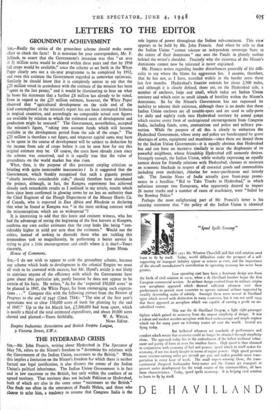LETTERS TO THE EDITOR
GROUNDNUT ACHIEVEMENT
Snt,—Really the critics of the groundnut scheme should make some effort to check the facts! It is nonsense for your correspondent, Mr. F. Jellinek, to assert that the Government's intention was that "an area of 31 million acres would be cleared within three years and that by 1950 full crops would be available," since the scheme as set forth in the White Paper clearly sets out a six-year programme to be completed by 1952, and even this estimate the Government regarded as somewhat optimistic. Similarly he should know that it is completely untrue to say that the £25 million voted in accordance with the estimate of the mission has been "spent to the last penny," and it would be illuminating to hear on what he bases his statement that a further £8 million has already to be voted. Even in regard to the £25 million estimate, however, the White Paper observed that "agricultural development on the scale and of the kind contemplated in the mission's report has not been 'attempted hitherto in tropical countries, and accordingly no comparable actual cost figures are available by relation to which the estimated costs of development and production might be assessed." The Government, nevertheless, accepted the mission's figure, "taking into account funds which will become available in the development period from the sale of the crops." The £25 million is therefore a net figure, and whatever capital sums may have to be spent in the course of development will be subject to deduction by the income from sale of crops before it can be seen how far out this original estimate may be. Of course, the costs have already risen since the scheme was conceived, and it is equally true that the value of groundnuts on the world market has also risen.
What, -then, is the purpose of this persistent carping criticism so bristling with quite inexcusable inaccuracies ? Is it suggested that the Government, which frankly recognised that such a gigantic project "clearly involves considerable risks," should therefore have abandoned the project, although, in fact, the Kongwa experiment has achieved already such remarkable results as I outlined in my article, results which have since been confirmed in glowing terms by no less an authority than the Chief Engineer of the Plough Department of the Massey Harris Co. of Canada, who is reported in East Africa and Rhodesia as declaring that what he found at Kongwa was "in the most striking contrast with the misconceptions which are so widespread "?
It is interesting to add that this latest and eminent witness, who has had the advantage of seeing the beginning of the first harvest at Kongwa, confirms my own earlier estimates that the crop looks like being "con- siderably higher in yield per acre than the estimates." Would not the critics, instead of seeking to discredit those who are tackling this tremendous task so magnificently, be performing a better service in trying to give a little encouragement and credit where it is due?—Yours


































 Previous page
Previous page